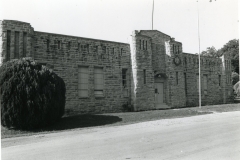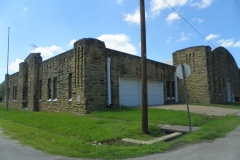| Address: | 823 East 8th, Pawhuska, Oklahoma | County: | Osage |
| Started: | Oct 1935 | Completed: | May 1937 |
| Agencies: | WPA | NRHP: | May 20, 1994 |
Current Usage:
Description:
A one unit facility, the Pawhuska Armory is rectangular (125′ x 135′) with offsets and is constructed of rusticated and generally coursed native sandstone. The stones were quarried some 3.5 miles west of the armory and many are huge. The roof is flat except over the drill fooor where it is arched. Parapets and pilasters, the latter at the corners and framing the main entry, provide decorative relief–as do vertical indentations in the rock work above the windows and below the parapets. The armory has elongated metal casement windows symetrically placed, three garage doors and a recessed main entryway.
SIGNIFICANCE: 1936; architect/builder: Bryan Nolan
The Pawhuska Armory is particularly significant because it was one of the structures sponsored by the WPA shortly after the agency was established. Along with other armories across the state, it was to provide job opportunities for unemployed and destitute workers during the desperate winter of 1935-1936. That the building program helped to salvage broken and hopeless lives makes the armory a symbol of a government that cared for its citizens. Just as notable is that the armory helped to prepare units of the 45th Infantry Division that within five short years would be winning distinction in battles in North Africa and Europe. The Pawhuska Armory, in this sense, contributed directly to American victory during World War II.
VERBAL BOUNDARY DESCR.IPTION: Lots 18-24, Block 42, Pawhuska original plat[1]
In 1935, Pawhuska needed a public works project such as an armory. Founded in 1872, the town was the site of the Osage Indian Agency and the seat of Osage County after statehood. The discovery of oil beneath prime grazing land at the turn-of-the-century made the Osage people the richest Native Americans in the world. Euro-Americans shared in the prosperity based on oil, natural gas, cattle, poultry, and small grain. Although the Osage area suffered less than the rest of Oklahoma in the 1930s, declines in oil and commodity prices combined with drought and a grasshopper infestation to produce hard times. In June 1935, when the WPA was created, 1,619 heads of families or single people were on relief rolls, a total of 14 percent of the county population. Construction of an armory would ease their hardship. Mayor Charles Bacon and City Manager Lee Houston quickly applied for a WPA armory. By early September, the city of Pawhuska demonstrated its commitment to the project by deeding a parcel of the city park to the state for a building site and by leasing part of the Ed P. Souligny acreage north of town for a quarry, thus meeting the requirement of community sponsorship. Construction of the Pawhuska Armory began in early October 1935 with 43 men at work quarrying the stone to be used on the project. By early November, 10 more were clearing the site for actual construction. Work stopped briefly in late November while state and federal WPA officials haggled over allocation of funds, but protests by the governor, second Congressional district representative, and Mayor Bacon helped reinstate the Pawhuska project. Work continued under the supervision of foreman Roy Beacroft through 1936 in spite of extreme winter cold and excessive summer heat. On October 25 the Pawhuska American Legion Post sponsored the official laying of the cornerstone. While skilled masons did the stonework, unskilled laborers did the rest. This included laying 148,000 small pine blocks which were cut cross-grain, sanded, inlaid in tar, and varnished to form the drill hall floor. Such labor-intensive work, organized in two shifts and limited to four working days per week, 130 hours per month, per laborer, took the maximum number of men off the relief rolls, meeting a WPA objective. The guaranteed wage of $23 per month gave the men back the ability to provide for themselves and their families. An estimated 90,000 man-hours was invested in the construction of the Pawhuska Armory by its completion in 1937. The dedication ceremony on May 24 was cause for an enthusiastic community celebration, attended by a number of state WPA dignitaries, including Oklahoma National Guard Major Bryan W. Nolen, the armory’s architect. 6 The Pawhuska Armory, built at a cost of $60,000, provided excellent facilities for the local Guard unit. The entire structure measured 125′ by 140′. The administrative section facing East Eighth Street contained offices, a classroom, 25′ by 30′ locker room, showers, an arms vault, and a garage for six trucks. The drill hall, designed to double as a community center and public meeting hall, was 78′ by 109′. At the west end was a 12′ wide and 78′ long stage. Footlights and floodlights illuminated stage and floor. Beneath the stage was a basement rifle range, 12′ by 102′, for indoor small arms practice. The size and style of the building made it a major addition to Pawhuska. Even before the dedication the building had begun to serve the community as a site for dances and as a convention center for the American Legion. Shortly after the dedication, the drill hall also housed a tent factory.
The National Guard unit that received the Pawhuska Armory as its headquarters dated back to the reorganization of the Oklahoma National Guard into the 45th Infantry (“Thunderbird”) Division in 1923. This was the second unit stationed in Pawhuska. The first, a company in the 160th Field Artillery, transferred to nearby Hominy, Oklahoma. The second unit, organized by Dr. Harold F. Ketchum who served as captain until 1938, was the 120th Veterinary Company, 120th Medical Regiment. [2]
Sources:
- Oklahoma Landmarks Inventory Nomination
- National Register of Historic Places Registration Form
- http://www.nbcnews.com/id/11289981/ns/world_news-mideast_n_africa/t/guard-troops-await-deployment-iraq/#.WuO7AcgvyHs
Supported Documents:
- WPA Properties Osage County – Pawhuska Armory
- National Register of Historic Places Support Document
- National Register of Historic Places Nomination Form
- Department of Environmental Quality Final Report
- http://deq.maps.arcgis.com/apps/MapSeries/index.html?appid=e39156eaa1be4d0b809a81833bc169b7
Photos:
Add Notes:







There was a wading pool on the north side. One summer (?1948), nearly everyday, my cousin and I walked the four blocks from my home on 12th to splash around in that pool. It was always just the two of us. I don’t recall ever seeing another child or adult. Those were the days.